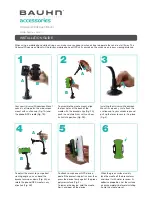
7
FIG. 9
Top Mounting
Bracket
Awning Rail
With Drip
Channel
Top Bracket
Spacer
2. Ensure the arm assemblies do not restrict use of
doors, windows, etc. See FIG. 10.
PREPARE FOR INSTALLATION
INSTALL THE AWNING
A. Installing The LED Light Switch
(If Applicable)
An LED light switch (installer supplied) is required
for awning models equipped with an LED light strip.
Skip this subsection if the awning is
NOT
equipped with an LED light strip.
1.
Do
NOT
expose switch to weath-
er, extreme temperatures, or long hours in direct
sunlight.
Find a suitable location for the LED switch instal-
lation.
2. Route wiring (inside the RV) to the general loca-
tion where connections to the awning hardware
will be made.
Allow enough wiring length to pass
through the outside of the RV wall (hole
will be drilled later) for connection to the
awning.
The wiring hole location will be near the
RH top casting. See FIG. 4.
3.
Disconnect the positive (+) 12
Vdc terminal from supply battery. Otherwise,
damage to unit could occur.
Make the appropriate wiring connections inside
the RV.
Wiring connections to the awning (through
the outside RV wall) will be made later.
The LED kit has a (6 A) rating. Wiring
MUST
be connected to an appropriately
rated, fused circuit.
B. Inserting The Awning Fabric Into The
Awning Rail
1.
Unfurl the awning fabric one revolution before
inserting the fabric (with awning roller cover, if
equipped) into the awning rail.
Unfurling one revolution will allow enough
space between the RV wall and awning
hardware to guide the fabric into the rail.
2.
LIFTING HAZARD. Use proper
lifting technique and control when lifting product.
Failure to obey this caution could result in injury.
With one person grasping each arm assembly,
carefully lift the entire awning assembly upright.
Then carry the awning to the prepared (flared)
awning rail end. See FIG. 11.
FIG. 11
Awning
Rail
Arm
Assembly
FRTA
FIG. 10
Arm Assemblies































